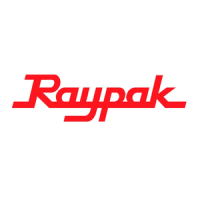
Do you have a question about the Raypak RP2100 P-R405A and is the answer not in the manual?
| Model | RP2100 P-R405A |
|---|---|
| Category | Swimming Pool Heater |
| Fuel Type | Natural Gas or Propane |
| Ignition | Electronic |
| Control Type | Digital |
| Efficiency | 82% |
| Voltage | 120V |
| Warranty | 5 years |
| Heat Exchanger | Copper |
Crucial safety warnings about fire, explosion, and gas leaks.
Lists the various heater models covered by this manual.
Specifies that installation and service require qualified personnel.
Discusses the new PVC union adapter for piping connections on the RP2100.
Emphasizes reading safety information before operating the heater.
Introduces the general start-up process for the heater.
Instructions for cleaning burners and ensuring a clear operating area.
Ensures water is flowing through the heater before operation.
Caution regarding propane gas handling and potential hazards.
Step-by-step guide for lighting the pilot manually on millivolt systems.
Steps to safely turn off the gas supply to the appliance.
Instructions for heaters with automatic pilot ignition systems.
Steps to safely turn off the gas supply for electronic ignition systems.
How to check burner and pilot flame appearance for correct operation.
Importance of the water pressure switch for heater safety.
Safety guidelines for user health and well-being in spas and hot tubs.
Guidelines for installing chemical feeders and chlorinators correctly.
Procedures for operating the heater safely in cold conditions.
Importance of proper water chemistry for heater longevity and efficiency.
Step-by-step guide for shutting down the heater for winter.
Instructions for checking heater components upon arrival.
Technical specifications and ratings of the heater.
Requirements for qualified installers and adherence to local codes.
Guidelines for mounting the heater on a suitable and level base.
Specifies necessary clearances from combustible surfaces for safety.
Instructions for installing the outdoor stackless vent top assembly.
Specifies required clearances for vent terminals in US and Canada.
Notes certification for indoor installation when using a draft hood.
Detailed steps for assembling and installing the indoor vent stack.
Table detailing BTU, dimensions, and shipping weights for various models.
Specifies minimum air openings needed for combustion and ventilation.
Recommendations for vent pipe sizing, runs, and support.
Instructions for safely connecting the gas supply line to the heater.
Details on gas pressure settings, testing, and adjustments.
Table for selecting correct gas pipe size based on equivalent length and gas type.
Instructions for connecting water lines to the heater inlet and outlet.
Notes on avoiding restrictions and connecting additional heated water sources.
Explanation of how the built-in bypass valve regulates water flow.
Required flow rates and when to use an external bypass valve.
Description of the Unitherm Governor's role in temperature regulation.
Details on installing a pressure relief valve and its safety function.
Detailed instructions for reversing the heat exchanger for Capron header models.
Guidelines for replacing existing heater wiring with correct types.
Description of the millivolt system's self-generating electrical setup.
Notes on field wiring connections for electronic ignition heaters.
Explains the color coding and symbols used in wiring diagrams.
Provides the specific wiring diagram for millivolt units.
Wiring diagram for IID atmospheric units.
Wiring diagram for IID Low NOx units.
Identifies the location of various control components on the heater.
Steps for safely removing the heater's control panel.
Details on operating and adjusting millivolt thermostats.
Explains the function of the digital control panel and its modes.
How to adjust maximum temperature limits for pool and spa modes.
Instructions for switching between Fahrenheit and Centigrade displays.
General notes for remote wiring installations, including conduit and cable type.
Installation guide for two-wire remote control systems.
Installation guide for three-wire remote control systems.
Procedure for adjusting the pressure switch for proper operation.
Explanation and function of the flame roll-out safety switch.
Information on high limit switches, their settings, and replacement.
How pilot safety features work in millivolt and electronic ignition systems.
Steps to remove the burner drawer for servicing or inspection.
Procedure for safely removing and replacing the gas valve.
How to remove main burners and clean or replace orifices.
Steps for removing and cleaning the pilot assembly.
Method for cleaning the heat exchanger tubes to maintain efficiency.
Steps for removing soot from the heater to prevent damage.
Procedures for replacing the control immersion well and Unitherm Governor.
General information and certification for Low NOx heaters.
Notes on burner visual inspection and adjustment for Low NOx models.
Specific start-up steps for Low NOx heater ignition systems.
Procedures for removing burner tray and gas valve on Low NOx units.
Steps for removing pilot assembly and combustion fan on Low NOx units.
Troubleshooting for humming, whining, and intermittent heater operation.
Solutions for sooting, lazy flames, pilot outages, and burner issues.
Troubleshooting for slow heating, leaks, and brittle gasket issues.
A flowchart for diagnosing electrical issues in millivolt systems.
Flowchart for troubleshooting Honeywell S8600 intermittent pilot ignition systems.
Explains how to interpret various diagnostic codes displayed on the unit.
Details on common fault codes (SNS, PRS, HL1, etc.) and their solutions.
Guidelines for specifying model, serial, and gas type when ordering parts.
Exploded view diagram of the Low NOx burner tray assembly.
Diagrams identifying different pilot assemblies used in the heaters.
Part numbers for burner trays, controls, and gas valves.
Part numbers for heat exchanger components and bypass valves.
Part numbers for metal heat exchangers and control box components.
Part numbers for pilot assemblies, generators, and ignition wires.
Part numbers for refractory, sheet metal, and venting components.
Part numbers for various gas conversion kits.
Outlines the basic warranty coverage, duration, and conditions.
Details warranty exclusions and the process for making a claim.
Section for recording owner, dealer, model, and serial numbers.

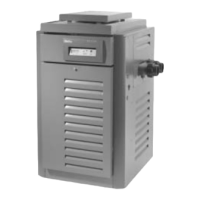
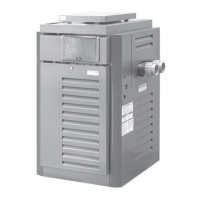
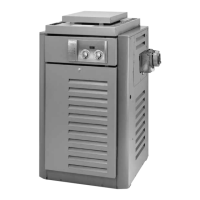
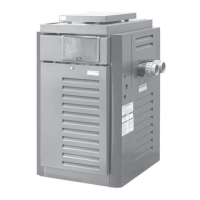


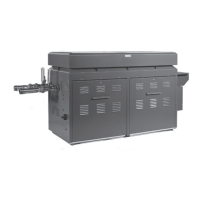
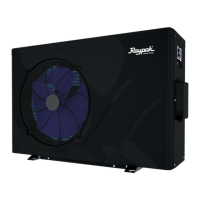
